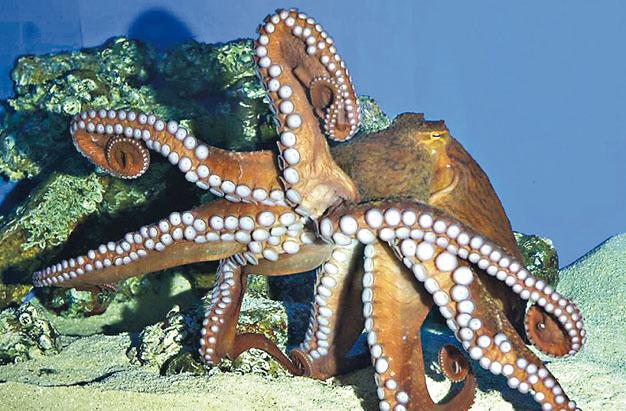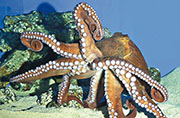Animal:Giant Pacific octopus
【明報專訊】We all know what an octopus is - a sea animal with eight arms. But do we know how awesome it truly is? The octopus is very curious and loves to learn. If we are just as curious to learn, we are in for a big surprise! Shall we take the giant Pacific octopus as our teacher?
TO begin with, it has an extraordinary body. There is so much more than just a sack-like(像大口袋的) body with eight waving arms attached! Its dorsal mantle is indeed like a sack but full of treasures, containing important body features such as the brain, eyes, as well as digestive and reproductive organs. Its eight arms have over 2,000 suckers which are super strong grippers and sensitive chemical receptors. Thanks to them, the giant Pacific octopus has an excellent sense of smell and taste.
Observe and learn
THE giant Pacific octopus also has extremely good eyesight. Its highly-developed vision enables it to observe small details. Its reddish skin is covered with special pigment cells(色素細胞) which allow it to change colours and textures. This makes it a master of imitation – it can easily blend in with the environment, mimicking corals, plants and rocks.
Living as a solitary creature, the giant Pacific octopus has a lot of time on its many hands to observe and learn. On top of that, it is a highly intelligent animal. In fact, it is the only species of invertebrate(無脊椎動物) known to learn through observation. In laboratory tests, the giant Pacific octopuses learn to mimic other octopuses, solve mazes and even open jars! In the wild, they are highly skilled at adapting objects as tools and using landmarks to navigate.
Formidable yet reclusive
AS suggested by its name, the giant Pacific octopus is impressive in size. Its mantle may only be 60cm long, but together with its arms, it measures almost 5m in average. The longest record is 9m! Weighing from 50kg to over 270kg, it is the world's largest octopus.
Found in the coastal waters of the North Pacific Ocean, all the way from Japan to Russia, and from Mexico to Alaska, giant Pacific octopuses like rocky reefs with sand-shell floors where they can live in dens(洞穴). They hunt at night and feed mostly on scallops, clams, abalones, sea snails, shrimps and crabs. Their thousands of suckers help them detect prey, and their beak-like mouth punctures holes in the prey, spits out toxic saliva and tears up flesh. The remains of their prey are deposited at the entrance of their den. They may stay in for weeks on end, leaving their den only to hunt, to escape predators or to mate.
Soon after breeding, giant Pacific octopuses die. The females spend months nursing and guarding their eggs, during which time they do not eat. Soon after the eggs hatch, they die, having accomplished their mission. A new generation of baby octopuses then inhabits and explores the ocean with new-found curiosity!
Text and photo: Ocean Park Hong Kong
■Glossary
extraordinary (adj) 非凡的
gripper (n) 夾子
imitation (n) 模仿
solitary (adj) 孤單的
[Smarties' Power English 第314期]






